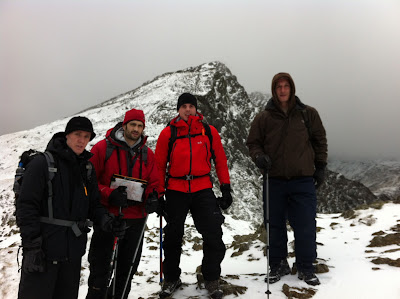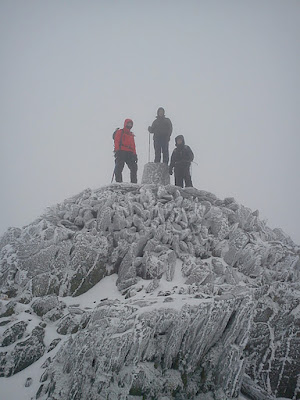So summer is here providing an ideal opportunity to reflect on kit for the coming winter. In mountaineering it's all about being well prepared and keeping light. Not always an easy balance to strike. I thought i would take the time to share my personal kit list for hiking up mountains in the UK. I would also use the same kit list for summer alpinism.
1. Boots
For winter mountaineering you need a winter boot with the ability to take a crampon. This means you will want either a B1, B2 or B3 boot. The higher the rating the firmer the sole, an important feature for crampons. For the UK or summer alpinism I would use a B2 boot with a C2 Crampon. But if you are looking for the best you won't go wrong with the La Sportiva Nepal Extreme B3 (left) at about £275.
2. Crampons
When it comes to crampons few would argue against Grivel. Tried and tested all over the world the Grivel crampon can be relied upon even under the harshest conditions. Like winter boots, crampons come with three ratings, C1, C2, C3. In general a C1 crampon will fit a B1 boot, a C2 will fit a B2 and a C3 will fit a B3. It's essential to get a correct fit so always check compatibility before you purchase. I've personally opted for the Grivel G12 (left) which is a C2 crampon with 12 points. You will be able to pick these up for about £135.
3. Socks
A decent pair of summit socks is an essential not to be neglected. I personally wear two pairs of regular socks underneath a 4 season summit sock, partly for good fit and partly to keep my toes warm. Summit socks like the ones I've purchased (left) can be bought for around £20. You won't regret it on a bitterly cold day.
4. Gaiters
In deep snow gaiters really come in handy. A decent pair of gaiters will prevent snow getting into your boots and ultimately soaking your feet. Wet feet soon get cold and could put an abrupt end to your day. For winter I would recommend that any gaiters are knee high. The good news is that these can be purchased from as little as £10.
5. Waterproof Over Trousers
As you might expect waterproof trousers are essential for any winter adventure. It doesn't have to be raining or snowing to bring these out of the rucksack. In mountaineering there is generally lots of work done on your hands and knees and a pair of waterproof trousers will ensure your knees remain dry and warm. As an absolute minimum you will require a half length zip to ensure you can put the trousers on over your boots. You don't want to be in the snowy mountains hopping on one foot! I personally will only wear waterproof trousers with a 3/4 length zip. If you want the best buy Rab Bergan Pants (left) for £120.
6. Waterproof Jacket
You might be surprised to know that when it comes to UK winter mountaineering you won't want a heavy insulated jacket. Believe it or not you get incredibly hot when on the move even in minus temperatures. Best to keep a number of layers in the rucksack and put them on when needed. For this reason I would recommend a light to middle weight waterproof jacket. If you want the best look for the Rab Latok Alpine Jacket, a favourite around the globe and available from approximately £200.
7. Gloves
When it comes to gloves you can never have enough. A mountaineering instructor once told me he can judge the success of the day by the number of pairs he gets through. The more the better. One thing is for sure, when it comes to gloves they are never 100% waterproof. Rain and snow is one thing but climbing in the snow with your hands will mean eventually they will start to get wet. When I go in the mountains i always take at least two pairs, one thermal inner and one waterproof pair. It's not unusual for people to take three or four pairs. If you want the best you can buy the Rab Ice Gauntlet gloves for £69. Alternatively you pick up a decent pair of gloves for around £20.
8. Hat and Neck Gaiter
This bit is easy, a decent hat and neck gaiter. No particular brand here guys and gals just something that is warm and hard wearing. £20 should see you with a decent one of each.
9. Rucksack
When out in the winter hills you want a good hard wearing rucksack between 35 and 45 litres. This should mean you can fit in your waterproofs, two-three layers, safety equipment and of course your lunch and water! Rucksacks are not waterproof so you have two options here. One is to purchase a very cheap rucksack liner for about £3 or another option is to purchase a waterproof cover which goes on the outside for about £10. It's down to personal preference here. I prefer a rucksack liner which can't blow away in the wind. As far as the rucksack I went for the Berghaus Arete 45 Litre. You can pick these up for approximately £40.
10. Ice Axe
Don't go up into the snow without it, it might just save your life. The ice axe is an essential tool in the winter mountains but it's only as good as your ability to use it. If you're buying one of these you should really be undergoing some training on how to use it. For general mountaineering a straight hiking axe of between 50 - 65 cm is recommended. I personally like to use mine as a walking aid and therefore have gone for a 70 cm ice axe which reaches the ground when my arm is hanging down by my side. If you look about you will be able to find one for around £50.
11. Head Torch
A good head torch might be an item that doesn't often come out of your backpack but if it's needed it could make the difference between getting down or spending a night stuck on the mountain. With that in mind it is worth investing in a good one. The Petzl Charlet Myo Head Torch comes in at about £45 and will give you about 72 hours of light. There are certainly cheaper ones out there but whatever you go for a halogen or super bright LED type is best. Remember that batteries suffer in the cold and therefore always go up with spares.
12. Sunglasses and Goggles
If the skies are clear in the snowy mountains the sunlight can be extremely strong. A good pair of sunglasses is highly recommended and in the Alps an absolute essential. If you're going really high and want the best go for Jublo Explorer Sunglasses, especially designed for high altitude and extreme sunlight. These don't come cheap and can be picked up for approximately £100. If you don't want to spend that much just make sure you have a good pair of sports sunglasses with high levels ultraviolet protection. When it comes to goggles the same applies.
13. Trekking Poles
Trekking poles could be considered optional and really it comes down to personal preference. I wouldn't leave without them, they help spread the load between you legs and arms. I also think that should you injure a leg they may help you get back down. If you're going to take some make sure they are lightweight but strong. Leki have just released the Makalu Khumbu Speedlock poles which fit the bill just perfectly. The flicklock system means you can keep your gloves on when you make adjustments. If you look around you will find these for around £65.
14. Map & Compass
Another example of an essential item that is only as good as your ability to use it. A good compass will keep you on track and should you stray, get you back home. A decent compass can be picked up for £10 - £30. A compass with the 1:50,0000 and 1:25,0000 scale helps when calculating distance in the cold.
15. Thermal Base layer
If your off into the winter mountains you will need a good set of thermal base layers. Ensure that you have top and bottoms and that the material will wick away moisture from your skin. A set will cost as little as £25 but ensure you are warm all day long.
16. Fleece Layers
I like to carry two fleece layers in my rucksack. One lightweight micro fleece and one mid layer fleece. If you have to stop for long you will want the option to add these layers under your jacket. The North Face offer a great range of fleeces and you will come away with one of each for about £60.
17. Hiking Trousers
A pair of lightweight hiking trousers are ideal to go under your waterproofs. I personally swear by Craghoppers which can be picked up for around £35.
18. Survival Bag / Emergency Shelter.
Pick one of these up for less than £5. If you get stuck it will provide a waterproof and highly visible bag to wait for assistance. You may also wish to take an emergency shelter up with you depending on where you are off to.
19. Other Essentials
Other items to add to your essentials list include a first aid kit, pocket knife, lighter, water resistant matches, candles, glow sticks, torch, water bottle, medication, watch and mobile phone.




















































